Zoom
Trash

Using Apache Spark DataFrames for Processing of Tabular Data. This post will help you get started using Apache Spark DataFrames with Scala on the MapR Sandbox.
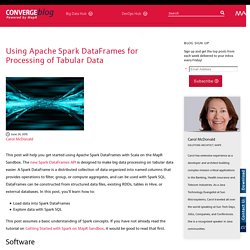
The new Spark DataFrames API is designed to make big data processing on tabular data easier. A Spark DataFrame is a distributed collection of data organized into named columns that provides operations to filter, group, or compute aggregates, and can be used with Spark SQL. DataFrames can be constructed from structured data files, existing RDDs, tables in Hive, or external databases.
In this post, you’ll learn how to: Using Apache Spark DataFrames for Processing of Tabular Data. Getting Started with Spark on MapR Sandbox. At MapR, we distribute and support Apache Spark as part of the MapR Converged Data Platform, in partnership with Databricks.
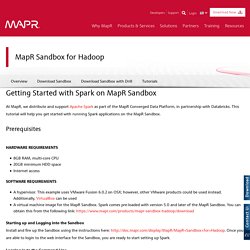
This tutorial will help you get started with running Spark applications on the MapR Sandbox. Prerequisites HARDWARE REQUIREMENTS8GB RAM, multi-core CPU20GB minimum HDD spaceInternet accessSOFTWARE REQUIREMENTSA hypervisor. This example uses VMware Fusion 6.0.2 on OSX; however, other VMware products could be used instead. Additionally, VirtualBox can be usedA virtual machine image for the MapR Sandbox.
Starting up and Logging into the Sandbox Install and fire up the Sandbox using the instructions here: Once you are able to login to the web interface for the Sandbox, you are ready to start setting up Spark. Logging in to the Command Line Before you get started, you'll want to have the IP address handy for your Sandbox VM. . $ ssh root@192.168.48 “How to” for a Spark Application Example Word Count App in Java Get a text-based dataset Pull down the text file: Software Suites for Data Mining, Analytics, and Knowledge Discovery.
Commercial | free 11Ants Model Builder, a desktop predictive analytics modeling tool, which includes regression, classification and propensity models.
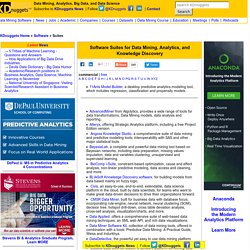
AdvancedMiner from Algolytics, provides a wide range of tools for data transformations, Data Mining models, data analysis and reporting. Alteryx, offering Strategic Analytics platform, including a free Project Edition version. Angoss Knowledge Studio, a comprehensive suite of data mining and predictive modeling tools; interoperability with SAS and other major statistical tools. Spark SQL for Real-Time Analytics. Apache Spark is the hottest topic in Big Data.
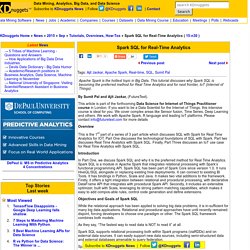
This tutorial discusses why Spark SQL is becoming the preferred method for Real Time Analytics and for next frontier, IoT (Internet of Things). By Sumit Pal and Ajit Jaokar, (FutureText). This article is part of the forthcoming Data Science for Internet of Things Practitioner course in London. If you want to be a Data Scientist for the Internet of Things, this intensive course is ideal for you. We cover complex areas like Sensor fusion, Time Series, Deep Learning and others. Overview This is the 1st part of a series of 3 part article which discusses SQL with Spark for Real Time Analytics for IOT. Introduction In Part One, we discuss Spark SQL and why it is the preferred method for Real Time Analytics. Objectives and Goals of Spark SQL While the relational approach has been applied to solving big data problems, it is in-sufficient for many big data applications. As they say, “The fastest way to read data is NOT to read it” at all.
Mikeaddison93/spark-csv. Build a CEP App on Apache Spark and Drools. Combining CDH with a business execution engine can serve as a solid foundation for complex event processing on big data.
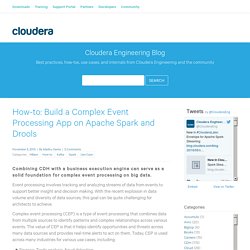
Event processing involves tracking and analyzing streams of data from events to support better insight and decision making. With the recent explosion in data volume and diversity of data sources, this goal can be quite challenging for architects to achieve. Complex event processing (CEP) is a type of event processing that combines data from multiple sources to identify patterns and complex relationships across various events. The value of CEP is that it helps identify opportunities and threats across many data sources and provides real-time alerts to act on them. Today, CEP is used across many industries for various use cases, including: Finance: Trade analysis, fraud detectionAirlines: Operations monitoringHealthcare: Claims processing, patient monitoringEnergy and Telecommunications: Outage detection Architecture and Design In the above picture: Coding Conclusion.
Deep Dive into Spark SQL’s Catalyst Optimizer. Spark SQL is one of the newest and most technically involved components of Spark.
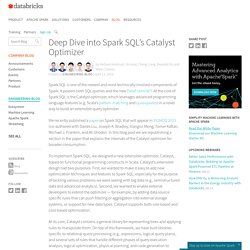
It powers both SQL queries and the new DataFrame API. At the core of Spark SQL is the Catalyst optimizer, which leverages advanced programming language features (e.g. Scala’s pattern matching and quasiquotes) in a novel way to build an extensible query optimizer. We recently published a paper on Spark SQL that will appear in SIGMOD 2015 (co-authored with Davies Liu, Joseph K. Using Apache Spark DataFrames for Processing of Tabular Data. Deep Dive into Spark SQL’s Catalyst Optimizer.